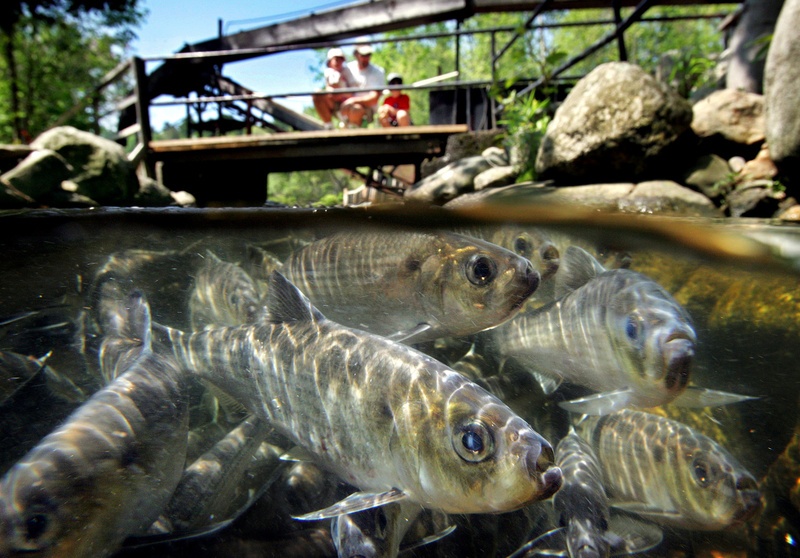Spring is here — or is it?
If you time the arrival of spring with a thermometer, it has been difficult to determine just what season it is, as temperatures have been a roller coaster ride. We have days that approach 80 in April and then some days in May when it’s a struggle to get to 40.
Fortunately, for those who don’t rely on the thermometer, there are other signs that spring fishing is in full swing, and that summer fishing is fast approaching.
A few weeks after ice went out, the chorus of peepers began early in the evening. Fast forward a few weeks later, and we saw fiddleheads poking their curled heads out of the forest floor.
More recently, scanning the banks along area rivers, you could see shadbush in bloom, which for anglers means fish are arriving.
Shadbush, the story goes, is appropriately named, since its pearly-white flowers bloom in concert with the arrival of spawning shad into East Coast rivers. Shadbush is easy to spot in your travels along the banks of a river or edge of marsh. Its bright white flowers stand out in early May among the trees whose leaves have not escaped their buds. In many cases, it is the only splash of color along the brown, rusted landscape.
More importantly for the angler, the bloom of shadbush not only signals the return of shad, which are showing up in increasing numbers in Maine, but the return of alewives to spawn — a sign of things to come for saltwater anglers.
The alewife is an anadramous fish that lives in the ocean but returns to fresh water to spawn. Alewife runs were once prolific all along the New England coast, but now, most major runs are limited to Maine.
The alewife is a slender, flat-bodied fish, 10 to 11 inches long and weighing about half a pound. Like shad and other herring, they are silver-sided, and have a dark green back with a black spot just behind the gill plate.
In Maine in the 1800s, alewives were an important food staple. They were smoked, pickled, salted, barreled and a welcome sign each spring. As time passed, human consumption waned, but their value as lobster bait grew. Their decline came with the construction of dams and heavy pollution in our rivers.
The Clean Water Act of the 1970s was the first step in restoring alewives, and was aided by the installation of fish ladders and fish lifts at dams that previously blocked their upstream migration.
A stocking program run by the state has helped increase the number of returning alewives, and while there are still threats, the outlook is better than just 15 years ago.
If you want to take a closer look at an alewife, take a trip to one of the area fish ladders that support upstream passage of these fish.
In Brunswick, right at the Frank J. Wood Bridge that connects Topsham with Brunswick, there is a fish ladder and viewing area at the dam. It is open from 1 to 5 p.m. Wednesday through Sunday during May.
You can also head to Damariscotta Mills, off of Route 215. There you can see a restored fish ladder, originally built by the towns of Newcastle and Nobleboro in 1807, which allows fish passage from Salt Bay to Damariscotta Lake.
So what does this mean to anglers? The alewife is an important link in the food chain, and while human consumption may be down, it is still a favorite of birds such as osprey, eagles, cormorants and gulls. You can see these predators at the base of fish ladders, ready to swoop or dive after their meal. They are a sign that fish are there.
Alewives are also a favorite of many predatory fish, including striped bass, and once you see them arriving to spawn in Maine rivers, stripers are not far behind.
Anglers already are catching stripers in the Great Salt Bay area of the Piscataqua River in New Hampshire, and Internet sites are talking about stripers in the Saco River as well.
So summer is coming, and even though the full moon in May just days ahead traditionally brings a frost, the alewife is a barometer that says summer fishing for stripers is rapidly approaching.
Mark Latti is the former public information officer for the Maine Department of Inland Fisheries and Wildlife, a Registered Maine Guide and a member of the New England Outdoor Writers Association. He can be reached at:
mlatti@gmail.com
Send questions/comments to the editors.



Success. Please wait for the page to reload. If the page does not reload within 5 seconds, please refresh the page.
Enter your email and password to access comments.
Hi, to comment on stories you must . This profile is in addition to your subscription and website login.
Already have a commenting profile? .
Invalid username/password.
Please check your email to confirm and complete your registration.
Only subscribers are eligible to post comments. Please subscribe or login first for digital access. Here’s why.
Use the form below to reset your password. When you've submitted your account email, we will send an email with a reset code.